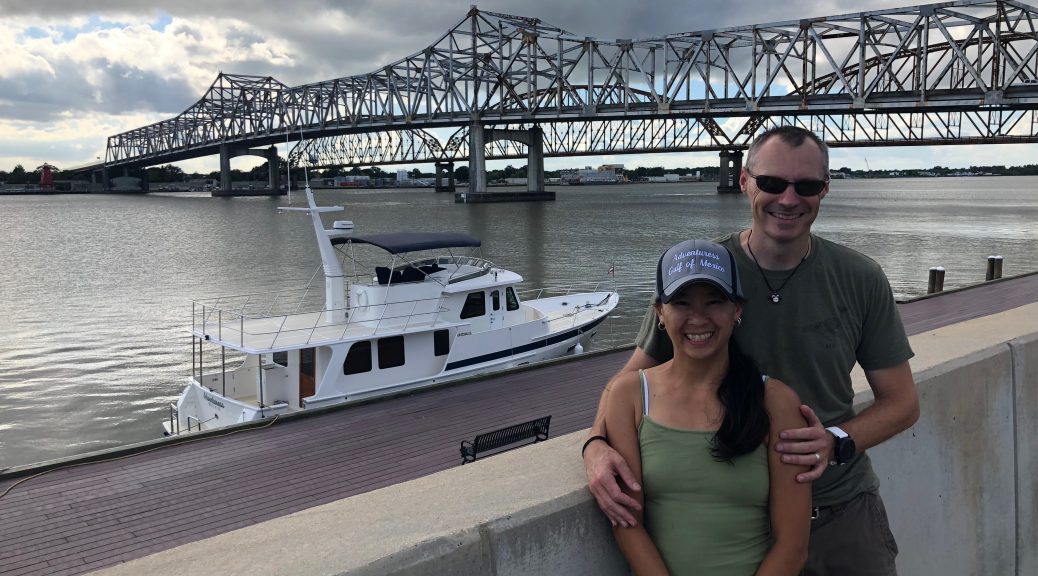
4 September 2018: Avoiding Gordon
-Editors Note 11 Sept 2018: We finally got into data coverage range and I’m doing some clean-up on the website. I realized that I never posted this entry, so here it is.
When we woke, NOAA had revised its estimate of when and where Gordon would make landfall, and it was good news for us, and not-so good news for Biloxi. But since Morgan City was west of New Orleans, things were looking better for holing up in Morgan City.
The journey down the ICWW from Intracoastal City to Morgan City is some fifty or so miles of lushly green bayou. The trees crowd each other elbow to elbow, each straining to reach beyond its neighbors’ crown into the hot swampy sunshine. Beneath the canopy, undergrowth is so thick the eye pierces but a few yards deep. If you get close to the land, you can see that it isn’t solid at all, but supported by the knobby knees of the mangrove trees, bowed out with the strain of holding the land up from the olivine waters. The water runs slow. The air moves slow. Even the shrill steady susurrus of swamp cicadas is slow. Life in the swamp is just slow.
Infrequently, we saw signs of human activity. A few barges pushed by tugs, the overwhelming majority with deeply religious names. Our Lady of Guadalupe, God’s Gifts, and The Rosary plied the waters with us this day, with no sign of the Savage tugs, or even Corky. Once we saw signs of habitation along the water.
But the irony of the day was that the sun shone for the most of the journey. Benign fluffy white cumulous clouds chased slowly across a sky almost uniformly blue. Just once a squall blew up, dropped its spiteful torrent of rain and then was gone.
And then just like that, we entered the Berwick Bay and were in Morgan City.
Originally a plantation owned and named for the Brashear family, Morgan City became prosperous in the 1800s as the intersection of several major rail and steamboat lines. Later, it was renamed Morgan City in honor of the then president of the railroad, Charles Morgan. Today, Morgan City’s major industry is shrimp and petroleum, which locals celebrate every Labor Day weekend with the annual Shrimp and Petroleum Festival. Sadly, we had just missed the fete.
Morgan City Public Dock is hunkered cozily between the rusty Southern Pacific Railroad bridge and much newer (or at least better kept) Highway 90 Bridge. It’s proud of itself, with a stretch of the public dock newly renovated and “Morgan City” proudly emblazoned on the twenty-two-foot flood wall. The city itself is ringed by a levee to protect itself from the fickle waters that surround it.
The railroad bridge is a lift bridge. That is, the whole bridge deck raises and lowers to accomodate river traffic. It stood up to permit a tug and her cargo to pass, so we radioed the bridge operator and were able to tuck in right behind.
Now tied up, I’m struck by the contrasts. By Louisiana standards, Morgan City is a prosperous town. There’s a lot of commerce that happens here and since leaving Texas, we are again some place that resembles more of what I’m used to.
Despite that, it is not at all like what I’m used to. We walked to the stores we needed to go to. And Morgan City had stores like Walgreens and Auto Zone. There were fast food joints and groceries. But the well-to-do neighborhoods were …nice, and the poor neighborhoods were …very poor.
Nevertheless, Southern hospitality is alive and well in Morgan City. The people are all very friendly and what help they can provide is offered with openhanded generosity.
We’ll be here for one other day as Gordon passes through.